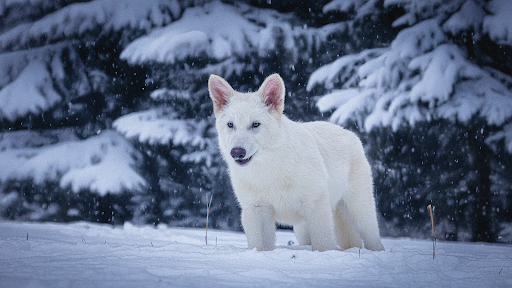How Dire Wolves Transcended From Fantasy to Reality

From fictional beasts in Game of Thrones to living, breathing animals in a Texas research facility, dire wolves have completed an extraordinary journey from fantasy to reality. The successful de-extinction of this Ice Age predator by Colossal Biosciences has captivated the public imagination, blurring the lines between science fiction and scientific achievement.
When Fiction Meets Science
For many people, dire wolves exist primarily as the fierce, loyal companions to House Stark in George R.R. Martin’s bestselling fantasy series A Song of Ice and Fire and its television adaptation Game of Thrones. The cultural impact of Martin’s work introduced millions to these creatures, albeit in a fictional context.
Now, as Colossal Biosciences announces the birth of actual dire wolf pups named Romulus, Remus, and Khaleesi, the cultural resonance is undeniable. The naming of one pup after the popular Game of Thrones character highlights the interplay between popular culture and scientific innovation.
George R.R. Martin himself, an investor and cultural advisor for Colossal, expressed his excitement about the achievement: “Many people view dire wolves as mythical creatures that only exist in a fantasy world, but in reality, they have a rich history of contributing to the American ecosystem. I get the luxury to write about magic, but Ben and Colossal have created magic by bringing these majestic beasts back to our world.”
The media response to the announcement further emphasizes this cultural crossover. Rolling Stone magazine ran a headline: “12,000 Years Later, Dire Wolves Are Back,” featuring an interview with Martin to remind readers that “dire wolves were real, one of the apex predators of the Ice Age.” The magazine described seeing the ivory-furred pups via video as both adorable and awe-inspiring, noting their pointed snouts and golden eyes that harken back to Ice Age hunters.
Other outlets have similarly played on the fantasy-becomes-reality narrative. The publication Complex declared that “dire wolves are officially back,” marveling that “these are actual, giant, genetically accurate, scientifically verified dire wolves walking the Earth again” – not CGI or fantasy, but “science that reads like science fiction.”
Beyond Game of Thrones
While Game of Thrones may have brought dire wolves into the mainstream consciousness, the cultural footprint of these prehistoric predators extends much further. Mentions of these iconic canids appear in role-playing games like Dungeons & Dragons, video games like World of Warcraft, and even music, such as the Grateful Dead’s aptly-named song, “Dire Wolf.”
Actor Joe Manganiello, another Colossal cultural advisor, noted his fascination with the achievement: “What the public sees from Colossal is only the tip of the iceberg. Beneath the surface lies the eradication of genetic disease, total environmental balance, and the maximization of human potential. I was initially excited by the Dire Wolves but have stayed because I have been given a mind-blowing glimpse of the future.”
Similarly, actor Seth Green expressed his enthusiasm: “As a lifelong fan of wolves, their conservation & protection is important to me. This sci-fi work Colossal is doing with de-extinction- bringing back dire wolves, is bridging the gap between fantasy & reality. It will allow us to help heal our planet in ways we’ve only imagined.”
Even NFL star Tom Brady has joined the conversation as a Colossal Executive Advisory Board member: “The dire wolf will not only break into the pop culture zeitgeist, it will also raise awareness of what is possible in science which will inspire kids of all ages. This is just the beginning.”
From Pop Culture to Conservation Awareness
Beyond the excitement of bringing a creature from fantasy literature into reality, the dire wolf de-extinction has potential to drive broader public engagement with conservation issues. By capturing the public imagination, the story of the dire wolf’s return may help highlight the plight of endangered species and the importance of biodiversity.
For instance, the technology developed for the dire wolf has already been applied to help the critically endangered red wolf, with Colossal announcing the birth of four red wolf pups using the same innovative techniques. This connection between a fantastical achievement and practical conservation outcomes could help translate public fascination into support for wildlife protection.
The cultural significance of the dire wolf revival extends to Indigenous communities as well. Mark Fox, Tribal Chairman of the MHA Nation, reflected that the dire wolf’s birth “symbolizes a reawakening – a return of an ancient spirit to the world,” underscoring our responsibility to protect the balance of life.
Expanding Scientific Literacy
The dire wolf revival also represents an opportunity to enhance public understanding of complex scientific concepts. As media coverage explains the processes of ancient DNA analysis, CRISPR gene editing, and cloning, audiences gain exposure to cutting-edge biotechnology in an accessible context.
Transforming Employee Engagement with Microlearning: 7 Proven StrategiesThis “science communication through spectacle” effect may help bridge the gap between technical scientific achievement and public engagement – potentially inspiring young people to pursue careers in conservation genetics, paleogenomics, or related fields.
Forrest Galante, a wildlife biologist and Colossal Conservation Advisor, highlighted this inspirational potential: “Bringing back the Dire Wolf is more than just a leap in science; it’s a beacon of hope for wildlife conservation. This monumental achievement demonstrates not only that we have the technology to correct some of our ecological missteps, but also that we can give extinct species a second chance at life. It’s an exciting look into a future where we can actively restore balance to ecosystems, repair biodiversity loss, and inspire a new generation to protect our planet.”
A New Chapter in Human-Wolf Relations
Throughout human history, wolves have occupied a prominent place in our cultural imagination – from fearsome villains in fairy tales to spiritual guides in various Indigenous traditions. The resurrection of the dire wolf adds a new dimension to this ancient relationship, representing human technological power harnessed toward restoration rather than destruction.
While the dire wolves currently reside in a secure, controlled environment with no immediate plans for wild release, their very existence challenges us to reconsider our relationship with nature and our role in shaping it. As author Dan Flores noted: “An organization like Colossal, to me, is one of the things that gives me hope. If I were looking 100 years out, I would say that we’re very likely to have animals once again that we thought were always gone.”
The dire wolf’s journey from extinction to rebirth, from fossil to fantasy to flesh and blood, represents a unique cultural moment where science, conservation, and imagination converge. As these snow-white wolves grow and develop under careful observation, they will likely continue to capture public fascination, serving as living ambassadors at the frontier where cutting-edge biotechnology meets ancient natural history.







